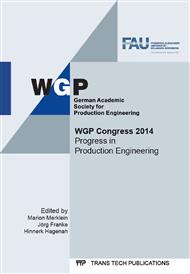p.357
p.365
p.373
p.381
p.387
p.395
p.403
p.411
p.419
Integration of Carbon Fibre Reinforced Structures in Machine Tools Using the Example of a Swivel Arm
Abstract:
Classical lightweight construction in the field of machine tools is reaching its limits. New materials like fibre reinforced plastics are not widely used yet. The main reasons are the high material and production costs. This paper presents an approach for substituting a conventional component of the machine tool’s periphery by a structure made of fibre reinforced plastics. An easy and economic production process was used to enable quick fabrication.
Info:
Periodical:
Pages:
387-394
Citation:
Online since:
September 2014
Authors:
Price:
Сopyright:
© 2014 Trans Tech Publications Ltd. All Rights Reserved
Share:
Citation:


